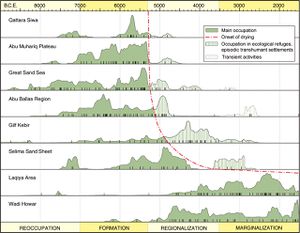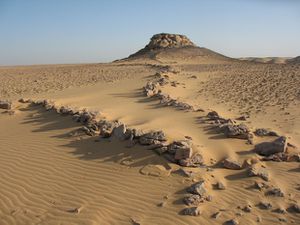Difference between revisions of "How did climate change influence the rise of ancient Egypt"
(→Climate in Egypt Before the Pharaohs) |
(→Climate and the Nile) |
||
| Line 9: | Line 9: | ||
==Climate and the Nile== | ==Climate and the Nile== | ||
| − | By around 5000 BC, the summer monsoons began to stop and northern Africa, and Egypt by extension, began to become more dry. People began to migrate more towards the Nile valley as it became a concentrated area for settlement. Agriculture began to play a more significant role, but hunting and fishing were still important. Parts of the Nile dried up, which meant that some major branches no longer flowed into the Nile. The Nile was becoming more a single, large stream river similar to today with relatively few branches. People did also begin to occupy major oases around Egypt, such as the Dakhala and Farfara. In many ways, this was the onset of the Neolithic in Egypt, as grain likely domesticated in the Near East made its way into the Nile valley. People were still relatively mobile and herding may have made a substantial contribution to diets, similar to the Sahel in Africa today. Between 4400-4000 BC, conditions became more dry and this may have led to increased prominence of grain agriculture, as it became harder to keep larger herds due to the dryness. The Nile now becomes the key area for social development as people are concentrated there. There was an acceleration of migration into the Nile valley during about 4000 BC. From about 4400 BC, a Mediterranean climate is evident, which was characterised by winter rains and almost no summer rains. | + | By around 5000 BC, the summer monsoons began to stop or at least shift (possibly going more to the south) and northern Africa, and Egypt by extension, began to become more dry. People began to migrate more towards the Nile valley as it became a concentrated area for settlement. Agriculture began to play a more significant role, but hunting and fishing were still important (Figure 2). Parts of the Nile dried up, which meant that some major branches no longer flowed into the Nile. The Nile was becoming more a single, large stream river similar to today with relatively few branches. People did also begin to occupy major oases around Egypt, such as the Dakhala and Farfara. In many ways, this was the onset of the Neolithic in Egypt, as grain likely domesticated in the Near East made its way into the Nile valley. People were still relatively mobile and herding may have made a substantial contribution to diets, similar to the Sahel in Africa today. Between 4400-4000 BC, conditions became more dry and this may have led to increased prominence of grain agriculture, as it became harder to keep larger herds due to the dryness. The Nile now becomes the key area for social development as people are concentrated there. There was an acceleration of migration into the Nile valley during about 4000 BC. From about 4400 BC, a Mediterranean climate is evident, which was characterised by winter rains and almost no summer rains. |
| + | |||
| + | [[File:Traps-01.jpg|thumb|Figure 2. Desert sites, such as this one, began to be abandoned in greater numbers after 5000 BC.]] | ||
==Climate in Egyptian Civilization== | ==Climate in Egyptian Civilization== | ||
Revision as of 09:08, 13 September 2018
Climate change today is seen as something that can bring down our societies and a potential threat to cities and civilization. While that has some truth to it, the fact is climate change is also likely a trigger for how our modern societies arose. In different parts of the world, major complex societies may have been influenced by climatic and various social factors interacting in a complex web of influences. This could have been the case for ancient Egypt as well.
Contents
Climate in Egypt Before the Pharaohs
During the early phases of agricultural development in the ancient Near East, Egypt was a society of small-scale hunter gatherers living not only in the Nile valley but also what are today the desert regions of North Africa and the deserts to the east and west of the Nile. At around 8000 BC, the climate had shifted from very dry conditions to much wetter conditions due to the global retreat of the great ice sheets and glaciers (Figure 1). The Sahara Desert, among the driest regions in the world today, was a savannah like environment more similar to the Serengeti than the harsh desert of today. People were able to roam in this region, living on hunting of big game such as elephants and wildebeests. Lakes and open woodlands were also found. The Nile certainly exists but was not only a more lush region and swampy as it was also influenced by summer monsoon rains that are more northerly than they are today. This also made the Mediterranean have more water flow into it, influencing rainfall conditions in Asia. In general, the relatively wet period was a conducive for hunting and gathering in north Africa and Egypt. Farming would have existed mostly in the Middle East, but it would not have been a major economic focus in Egypt between 8000-5000 BC. Domestic animals do appear more at around 6000 BC, including cattle, suggesting herders were also beginning to develop.
Climate and the Nile
By around 5000 BC, the summer monsoons began to stop or at least shift (possibly going more to the south) and northern Africa, and Egypt by extension, began to become more dry. People began to migrate more towards the Nile valley as it became a concentrated area for settlement. Agriculture began to play a more significant role, but hunting and fishing were still important (Figure 2). Parts of the Nile dried up, which meant that some major branches no longer flowed into the Nile. The Nile was becoming more a single, large stream river similar to today with relatively few branches. People did also begin to occupy major oases around Egypt, such as the Dakhala and Farfara. In many ways, this was the onset of the Neolithic in Egypt, as grain likely domesticated in the Near East made its way into the Nile valley. People were still relatively mobile and herding may have made a substantial contribution to diets, similar to the Sahel in Africa today. Between 4400-4000 BC, conditions became more dry and this may have led to increased prominence of grain agriculture, as it became harder to keep larger herds due to the dryness. The Nile now becomes the key area for social development as people are concentrated there. There was an acceleration of migration into the Nile valley during about 4000 BC. From about 4400 BC, a Mediterranean climate is evident, which was characterised by winter rains and almost no summer rains.
Climate in Egyptian Civilization
In the 4th millennium BC, the Nile, became less predictable. From around 3700 BC, the Nile may have periodically flooded more than expected while in other years floods were too low. Although the patterns of the annual Nile flood, which was critical to agriculture, had set in, the timing and fluctuations were not stable. This could have been due to fluctuating monsoon rains in central Africa that was influencing Nile flooding. It was during this time we begin to see settlements becoming larger but also more distant from the flood areas of the Nile. The settlements around Naqada become among the most important areas for Egypt in this time and develop early proto-kings that influence much of Egypt. Hierakonpolis also arose as a possible rival to Naqada. The limitation of resources that were once found in the deserts along with less predictable flooding has led some to speculate that these could have been the triggers to the social stratification and inequality that led to the rise of Pharaohs or at least kings that would have held some regional power as they competed with potentially other actors. While the Nile became more dry, this could have made the river less marshy and thus more useful for both agriculture and settlement. In other words, in earlier periods there may have been too much water, while during the the 4th millennium BC it became now suitable for major towns and cities to begin to form. There were likely some brief wet episodes during this time but in general the climate became more dry and resources and people began to be concentrated along the Nile, leading to the great social stratification and hierarchy that became associated with Egyptian civilization.
After 3500 BC, the last remaining margins outside of the Nile were mostly abandoned, with the exception of a few oases. Nile records soon began to be recorded by the now rapidly arising Egyptian societies along the Nile. From around 3000 BC, stability of the Nile became more evident. The floods were predictable and providing the fertility and water needed for crops to be grown in the Nile valley. The first unifying pharaohs arose by around 3200-3100 BC. The combination of predictable flooding and concentrate populations in the Nile valley made it easier for pharaohs to rule a larger population, but this was also made possible by the increasing aridity that had occurred over the previous millennia. Stability through the benefaction of the gods and pharaoh became a key theme in Egyptian civilization, which was influenced by the largely predictable climate of Egypt.
However, stability was not always that long lasting. By around 2400 BC, rainfall in the equatorial regions of Africa, which affected the annual flooding of the Nile that was needed for agriculture, began to diminish. Around 2200 BC, conditions became even more arid and this may have contributed to the crisis of the late 3rd millennium in ancient Egypt with the fall of Old Kingdom Egypt. Once again, climate may have played some role in creating famine or some loss of stability for the state authorities that challenged their ability to control the population. Rebellions against the state developed and Egypt broke into multiple kingdoms. It would reemerge as a unified state after 2000 BC, but climate continued to influence Egyptian civilization in the centuries to come. Egypt, at times, would emerge as the breadbasket for major empires, such as the Roman Empire, but at other times would experience famine. So long as the monsoon rains were stable, Egypt thrived, but once there was disruption to the summer monsoons then it often began to crumble as a central, unified state.
Summary
If we were to go to Egypt in 8000 BC, we would see a very different place that is much wetter than today's desert environment. In fact, the Nile may have not been the ideal place to live, as it was swampy and could have been malaria infested. However, as drier conditions began to develop after 5000 BC, we see populations concentrating more in the Nile valley. This helped to trigger social complexity and accumulation of goods into fewer hands, helping to lead to the rise of pharaohs and what became Pharaonic Egypt. While climate change may have helped trigger the rise of the ancient Egyptian state, it also threatened it such as at around 2000 BC when diminished monsoons may have led to low Nile flooding and widespread famine.

